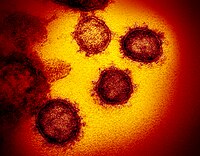
Photo from wikipedia
The novel Severe Acute Respiratory Syndrome Coronavirus 2 (SARS-CoV-2 or COVID-19) has led to a world-wild pandemic. The replication of SARS-CoV-2 RNA genome involves the core replication-transcription complex (RTC, nsp12-nsp7-nsp8)… Click to show full abstract
The novel Severe Acute Respiratory Syndrome Coronavirus 2 (SARS-CoV-2 or COVID-19) has led to a world-wild pandemic. The replication of SARS-CoV-2 RNA genome involves the core replication-transcription complex (RTC, nsp12-nsp7-nsp8) and the proofreading complex (nsp14-nsp10) that can correct mismatched base pairs during replication. Structures and functions of SARS-CoV-2 RTC have been actively studied, yet little is known about SARS-CoV-2 nsp14-nsp10. Here, we purified, reconstituted, and characterized the SARS-CoV-2 nsp14-nsp10 proofreading nuclease in vitro. We show that SARS-CoV-2 nsp14 is activated by nsp10, functioning as a potent RNase that can hydrolyze RNAs in the context of single- and double-stranded RNA and RNA/DNA hybrid duplex. SARS-CoV-2 nsp14-nsp10 shows a metal-dependent nuclease activity but has different metal selectivity from RTC. While RTC is activated by Ca2+, nsp14-nsp10 is completely inhibited. Importantly, the reconstituted SARS-CoV-2 nsp14-nsp10 efficiently removed the A:A mismatch at the 3′-end of the primer, enabling the stalled RTC to restart RNA replication. Our collective results confirm that SARS-CoV-2 nsp14-nsp10 functions as the RNA proofreading complex in SARS-CoV-2 replication and provide a useful foundation to understand the structure and function of SARS-CoV-2 RNA metabolism.
Journal Title: Protein Expression and Purification
Year Published: 2021
Link to full text (if available)
Share on Social Media: Sign Up to like & get
recommendations!